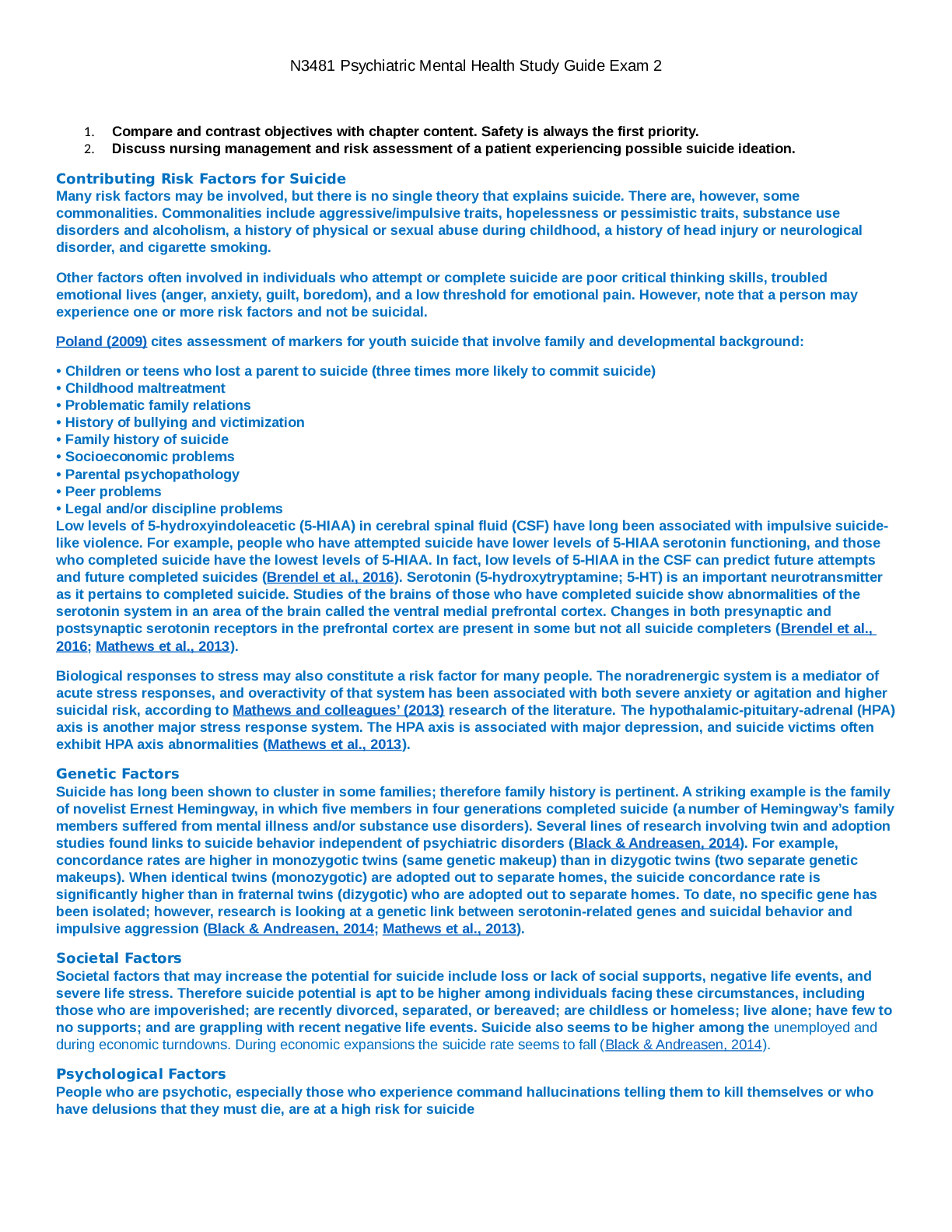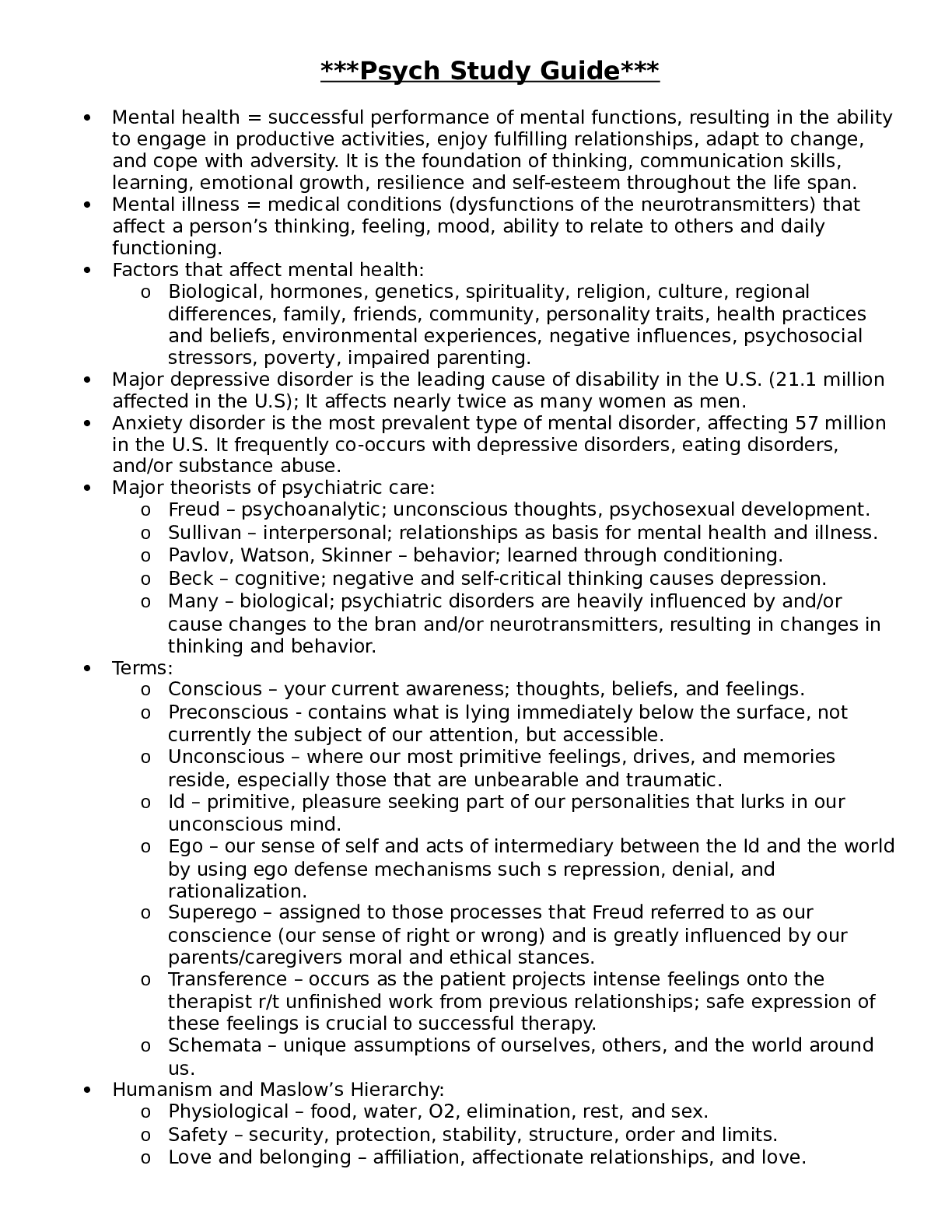*NURSING > Study Notes > N3481 Psychiatric Mental Health Study Guide Exam 2 (All)
N3481 Psychiatric Mental Health Study Guide Exam 2
Document Content and Description Below
N3481 Psychiatric Mental Health Study Guide Exam 2 1. Compare and contrast objectives with chapter content. Safety is always the first priority. 2. Discuss nursing management and risk assessment of ... a patient experiencing possible suicide ideation. Contributing Risk Factors for Suicide Many risk factors may be involved, but there is no single theory that explains suicide. There are, however, some commonalities. Commonalities include aggressive/impulsive traits, hopelessness or pessimistic traits, substance use disorders and alcoholism, a history of physical or sexual abuse during childhood, a history of head injury or neurological disorder, and cigarette smoking. Other factors often involved in individuals who attempt or complete suicide are poor critical thinking skills, troubled emotional lives (anger, anxiety, guilt, boredom), and a low threshold for emotional pain. However, note that a person may experience one or more risk factors and not be suicidal. Poland (2009) cites assessment of markers for youth suicide that involve family and developmental background: • Children or teens who lost a parent to suicide (three times more likely to commit suicide) • Childhood maltreatment • Problematic family relations • History of bullying and victimization • Family history of suicide • Socioeconomic problems • Parental psychopathology • Peer problems • Legal and/or discipline problems Low levels of 5-hydroxyindoleacetic (5-HIAA) in cerebral spinal fluid (CSF) have long been associated with impulsive suicidelike violence. For example, people who have attempted suicide have lower levels of 5-HIAA serotonin functioning, and those who completed suicide have the lowest levels of 5-HIAA. In fact, low levels of 5-HIAA in the CSF can predict future attempts and future completed suicides (Brendel et al., 2016). Serotonin (5-hydroxytryptamine; 5-HT) is an important neurotransmitter as it pertains to completed suicide. Studies of the brains of those who have completed suicide show abnormalities of the serotonin system in an area of the brain called the ventral medial prefrontal cortex. Changes in both presynaptic and postsynaptic serotonin receptors in the prefrontal cortex are present in some but not all suicide completers (Brendel et al., 2016; Mathews et al., 2013). Biological responses to stress may also constitute a risk factor for many people. The noradrenergic system is a mediator of acute stress responses, and overactivity of that system has been associated with both severe anxiety or agitation and higher suicidal risk, according to Mathews and colleagues’ (2013) research of the literature. The hypothalamic-pituitary-adrenal (HPA) axis is another major stress response system. The HPA axis is associated with major depression, and suicide victims often exhibit HPA axis abnormalities (Mathews et al., 2013). Genetic Factors Suicide has long been shown to cluster in some families; therefore family history is pertinent. A striking example is the family of novelist Ernest Hemingway, in which five members in four generations completed suicide (a number of Hemingway’s family members suffered from mental illness and/or substance use disorders). Several lines of research involving twin and adoption studies found links to suicide behavior independent of psychiatric disorders (Black & Andreasen, 2014). For example, concordance rates are higher in monozygotic twins (same genetic makeup) than in dizygotic twins (two separate genetic makeups). When identical twins (monozygotic) are adopted out to separate homes, the suicide concordance rate is significantly higher than in fraternal twins (dizygotic) who are adopted out to separate homes. To date, no specific gene has been isolated; however, research is looking at a genetic link between serotonin-related genes and suicidal behavior and impulsive aggression (Black & Andreasen, 2014; Mathews et al., 2013). [Show More]
Last updated: 1 year ago
Preview 1 out of 35 pages
Instant download

Buy this document to get the full access instantly
Instant Download Access after purchase
Add to cartInstant download
Reviews( 0 )
Document information
Connected school, study & course
About the document
Uploaded On
Oct 11, 2021
Number of pages
35
Written in
Additional information
This document has been written for:
Uploaded
Oct 11, 2021
Downloads
0
Views
47



 (1).png)



